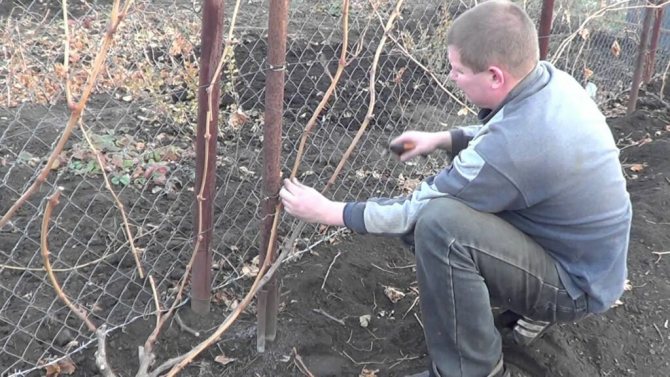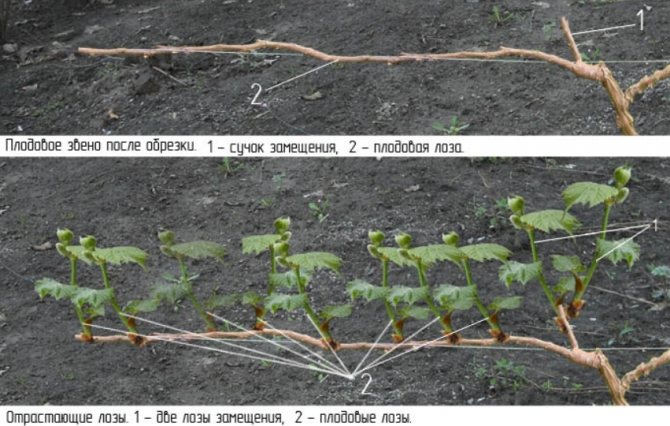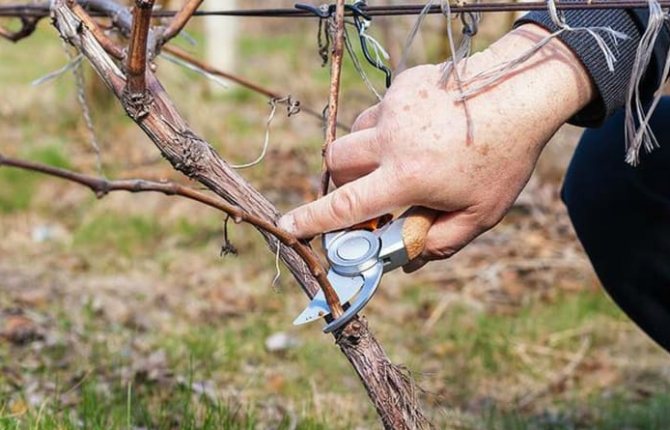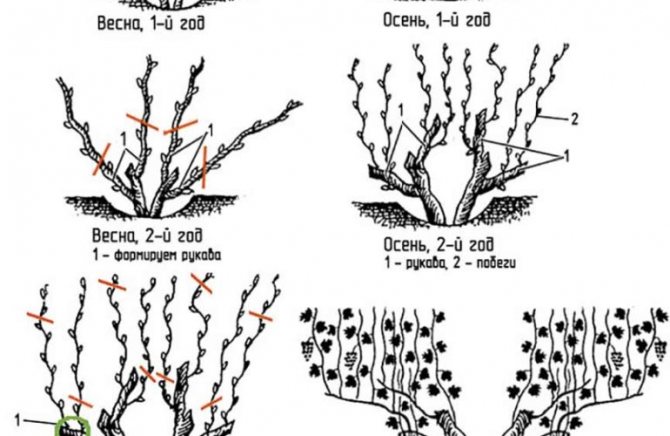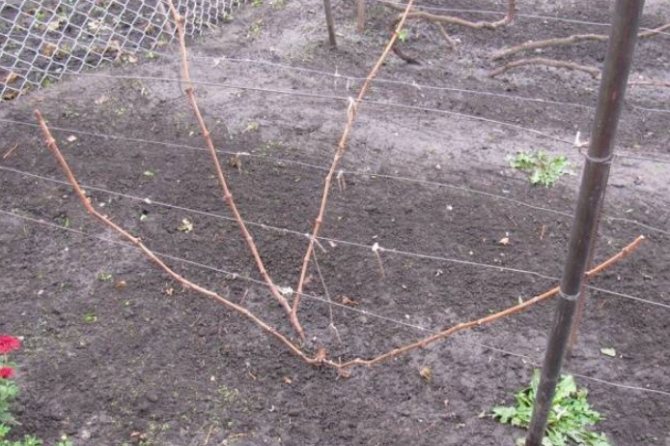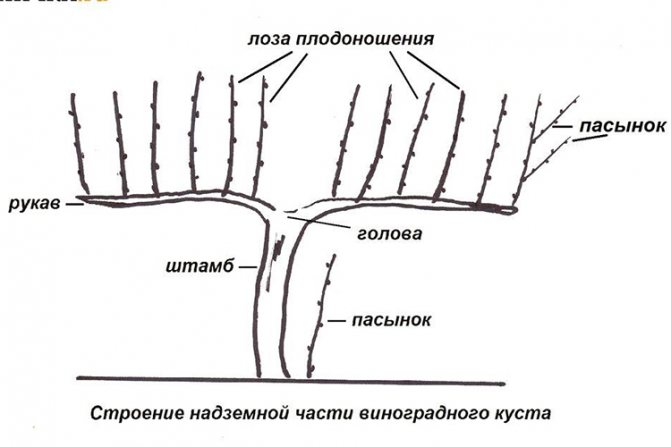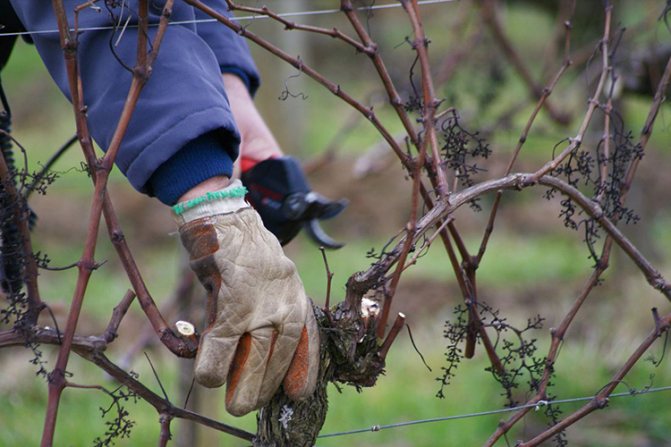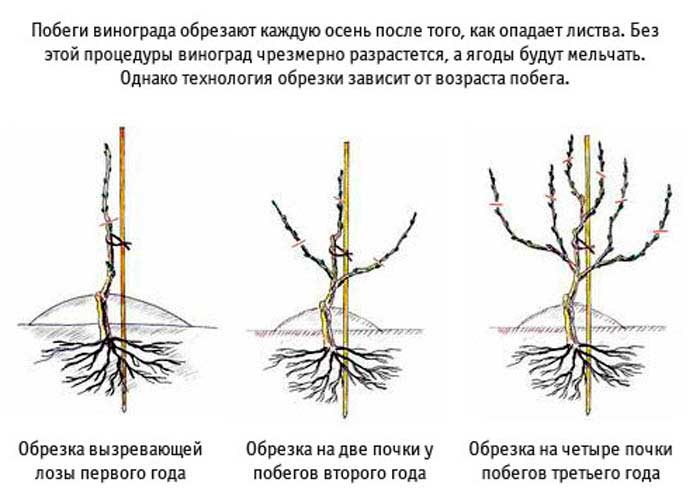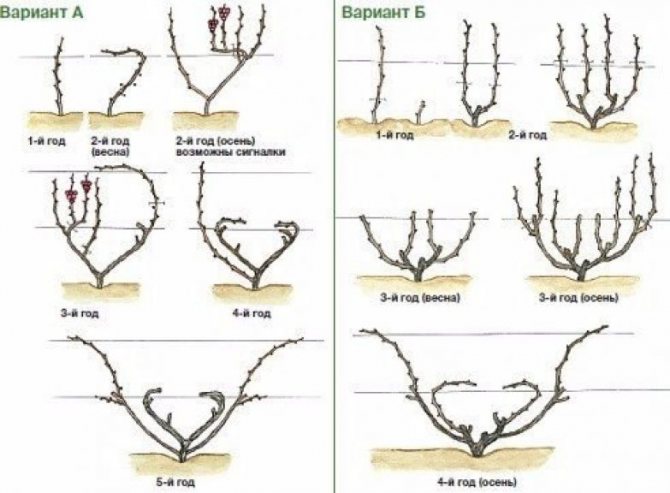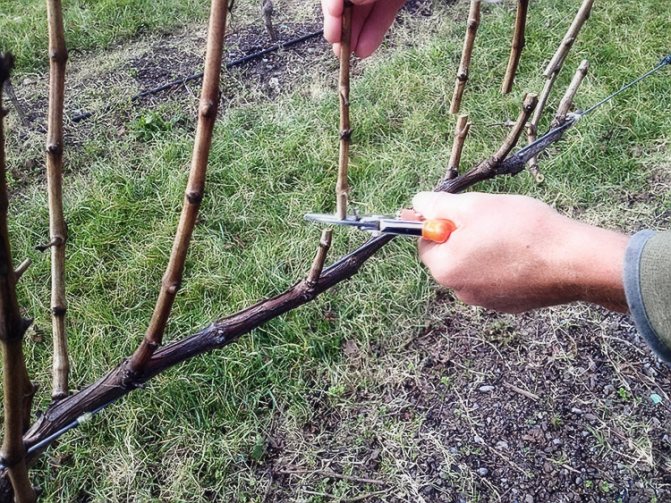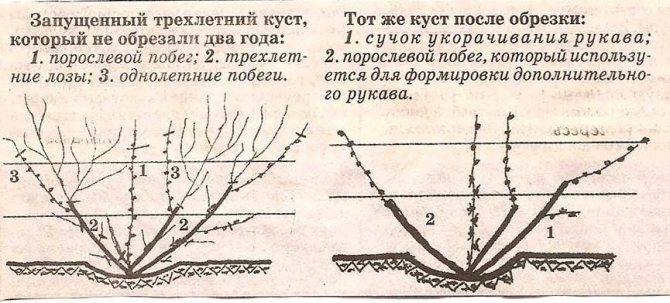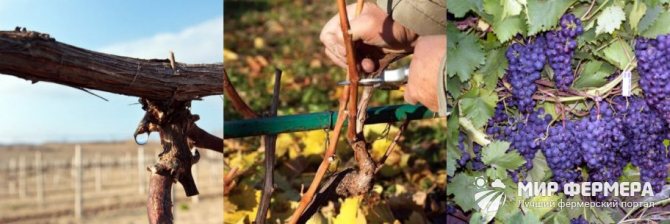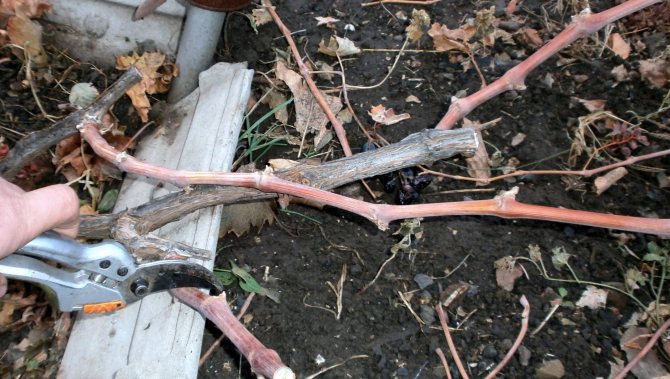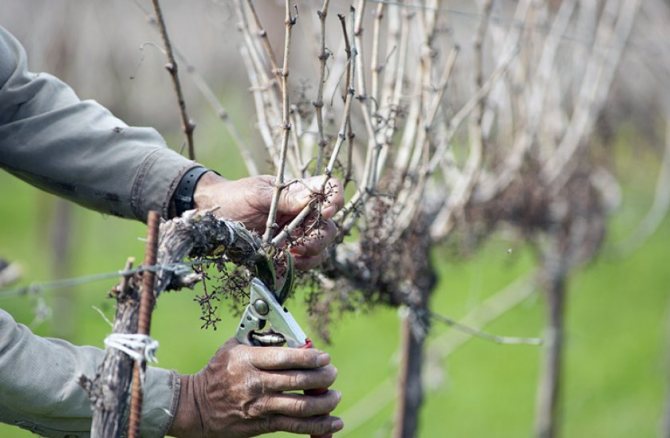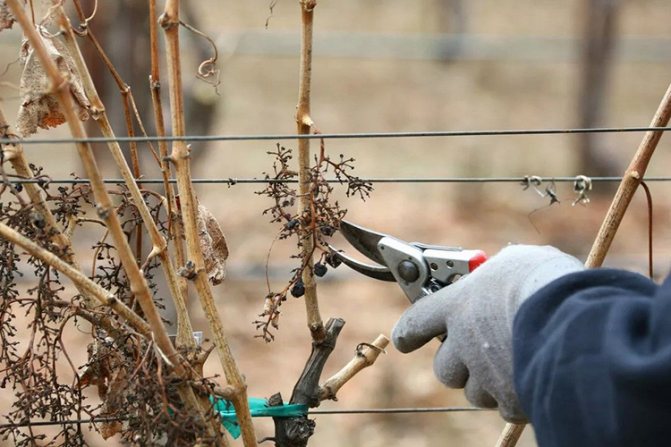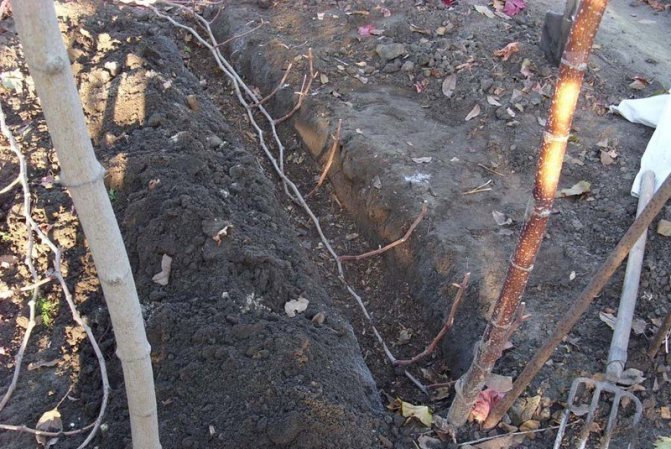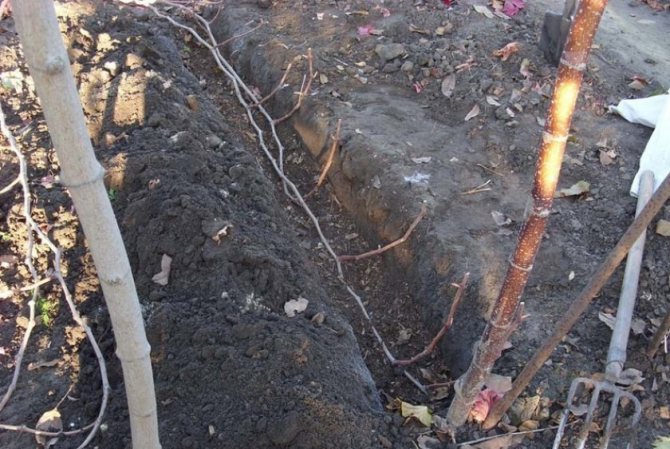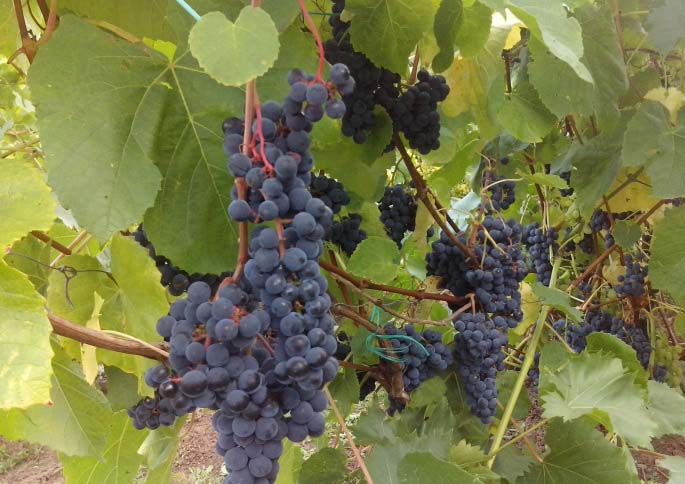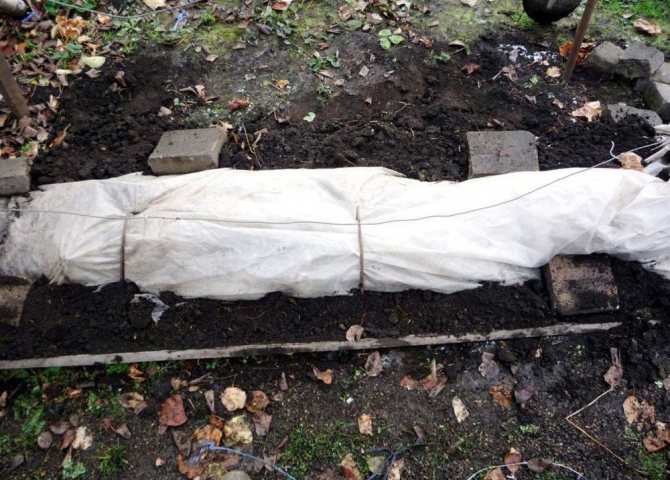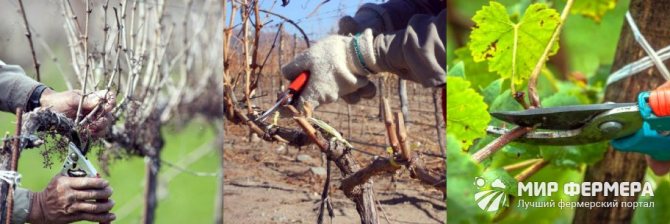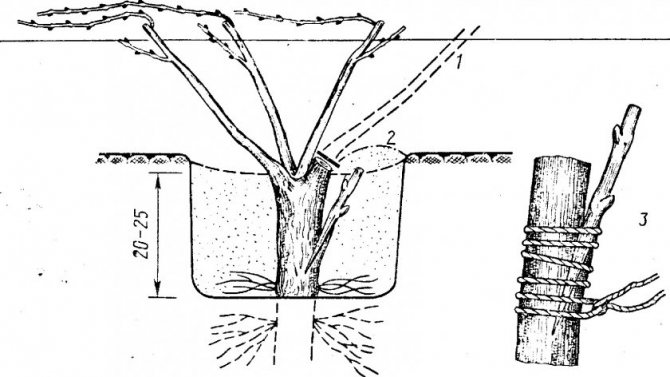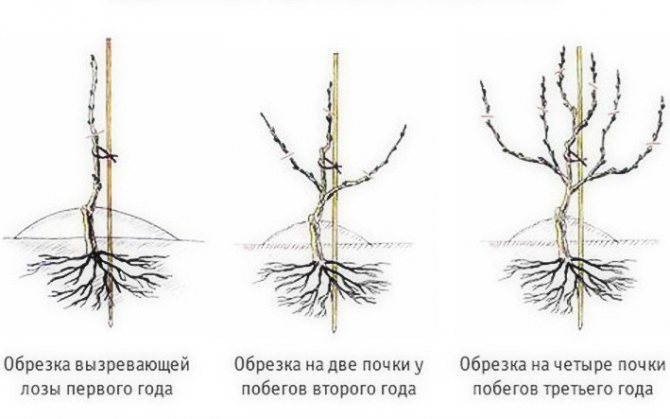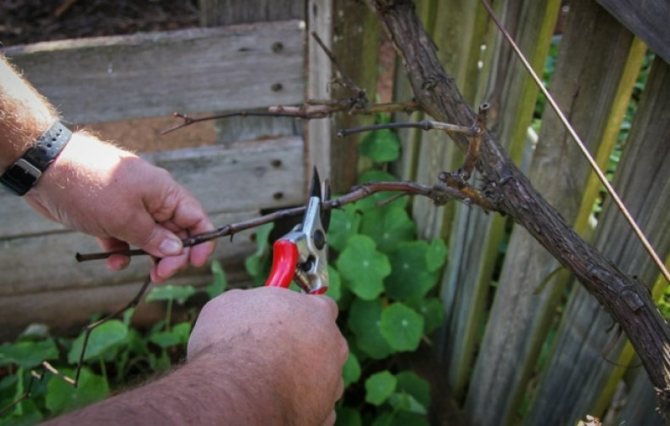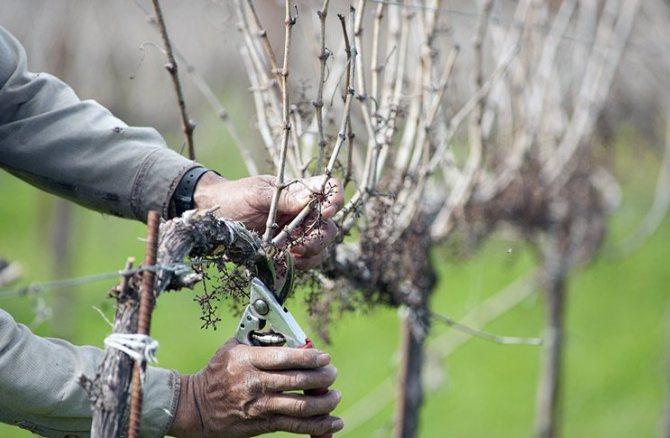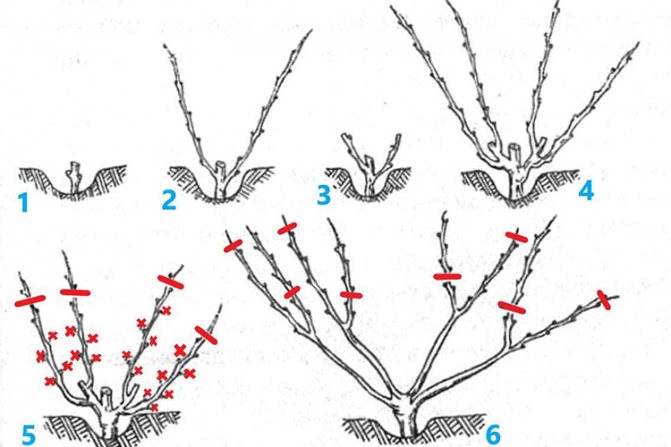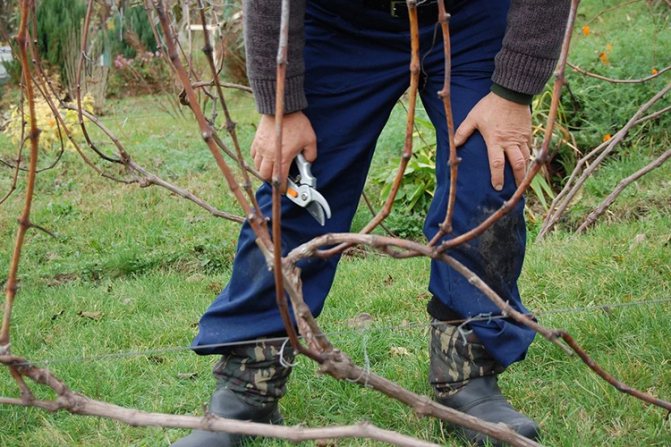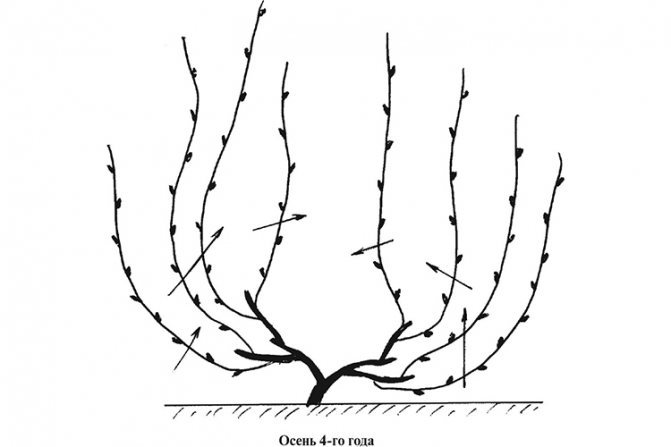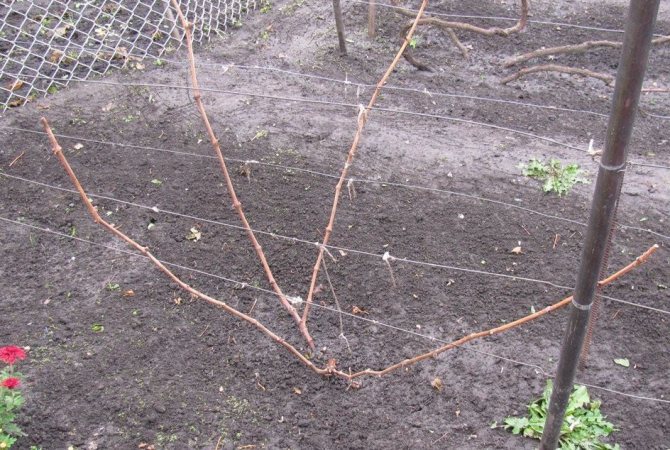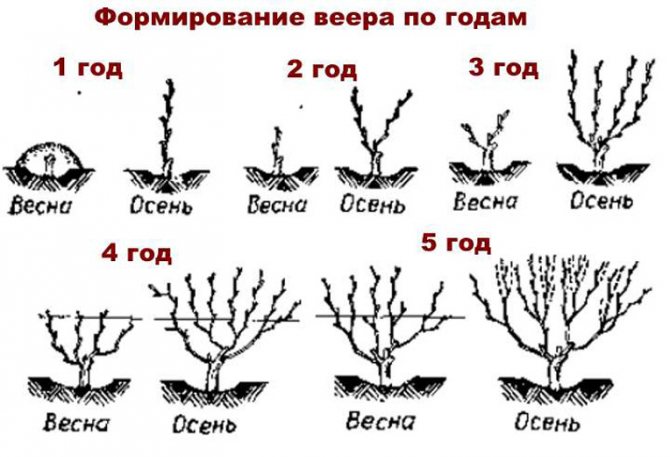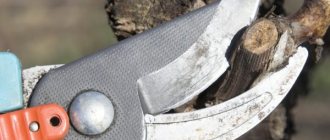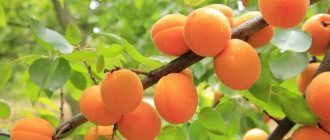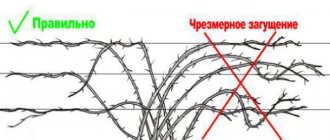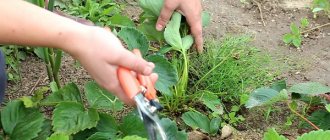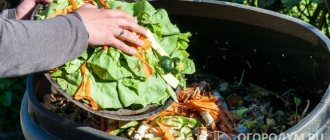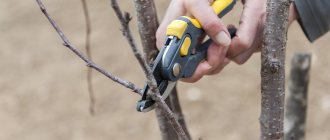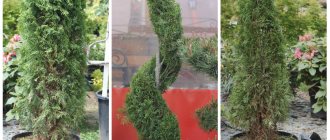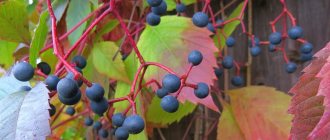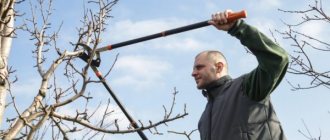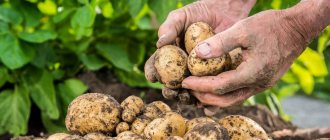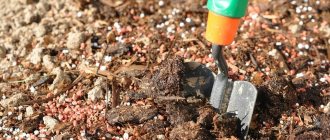Preparation of the vineyard for wintering begins with pruning and ends with a shelter. The harvest of the next year, the strength of growth and fruiting, the longevity of the plant depend on this procedure no less than on the variety and age of the vine. Thanks to the possibilities of autumn pruning, the bush becomes compact as painlessly as possible, because sap flow slows down by this moment. And a properly formed fruit link guarantees an excellent grape harvest in the garden.
- 2 Basic rules for pruning vines in the fall
2.1 Types of pruning
- 2.2 Formation of the fruit link
2.2.1 Photo gallery: pruning grapes with different formations of the bush
- 2.3.1 Video: how to properly prune grapes in the fall
Grapes - the structure of the bush
To carry out pruning correctly, you need to understand how the plant works, which parts are intended for what and how they differ.
What's underground
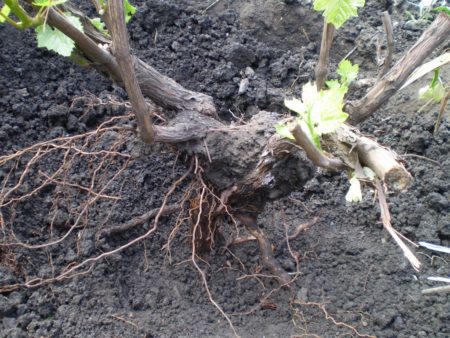
At a soil depth of 30-60 cm, there is the main root system - a stem. But, depending on the terrain and soil, it can reach 4 meters or more. The base of the trunk ends with a heel. In width, the roots grow up to 3 meters in diameter. Therefore, this should be borne in mind when considering planting plants next to grapes. Over time, old roots die off, and young ones develop.
What's above the ground
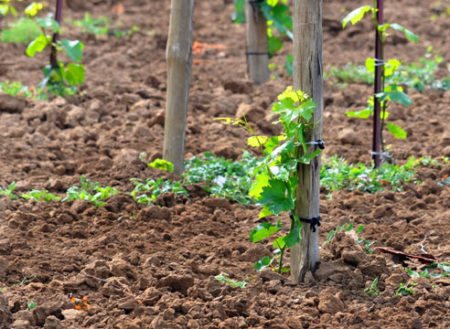

The vertical stem above the ground, from which the shoots are formed, is called the head. The side shoots that grow from the main stem are called sleeves or shoulders. This is a perennial (old) part of the bush. The short branches extending from them are horns.
The branch with 10 buds (long sleeve) is called the fruit arrow. After the end of the growing season, it is removed, and a new one is made from the young shoots formed on the replacement knot, which will bear fruit.
A vine that has a pair of buds (short sleeve) left after pruning is called a replacement knot. It grows under the fruit arrow. The shoots that have grown on it will serve in the fall to create a fruit link. The branch consists of fruit arrows and a replacement knot.
Helpful Tips for Beginners
When carrying out work, it is important to choose the right time so that the plant does not experience additional problems. A dry, cool day is good for pruning grapes in the fall. You can watch a video for beginners.
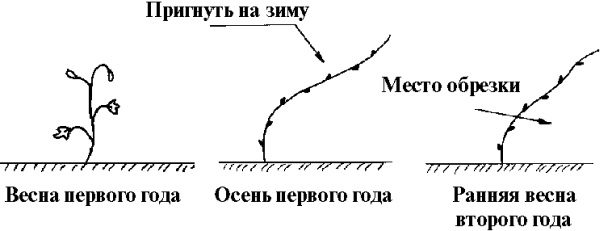

Let's give some more tips:
- Pruning is carried out not only to form a bush, but also throughout the entire growth of the plant. In addition to caring for fruiting branches, new ones should be formed, which in a few years will take their place.
- It is imperative to disinfect the tool with which you are going to prune.
- In the fall, it is made after the grapes have dropped all the leaves.
Remember: each variety has its own characteristics, advantages and disadvantages, which are also important to consider.
Why prune
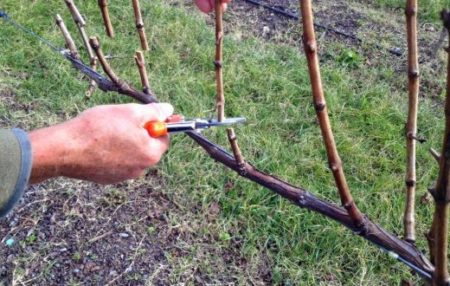

Normal growth and development of the plant depends on the nutrition of the bush. And pruning regulates the distribution of nutrients in the grape bush.
Vertical polarity is the pulling of the plant up towards the light. All nutrients are consumed in this growth process. The lower part of the grapes, however, suffers from a shortage of them.
To get a crop from the upper and lower branches, you need to distribute the intake of nutrients throughout the plant. After pruning, the polarity changes, and the bush begins to develop on all branches (self-preservation instinct).
Purpose of trimming:
- increase the yield;
- make the berry better, bigger;
- form new fruiting branches;
- rejuvenate and heal the plant;
- remove old unnecessary branches for better penetration of sunlight and heat transfer.
Pruning rules
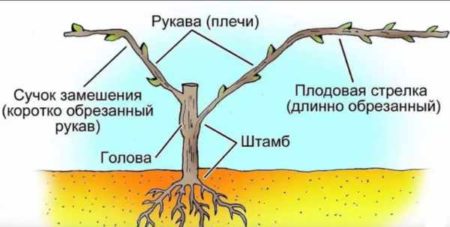

It is important to know what gives the crop - a long vine, it is also a fruit arrow. And the growth of the bush is a replacement knot, it is also a short branch.
When pruning the vine, you need to leave a "stump", about 3 cm. If you remove more, then the branch may dry out in this place. Remove unripe vines to the woody part.
Make sanitary pruning: destroy sick and bad shoots. Leave young pagons for further fruiting those that are closer to the center. They need to get rid of stepchildren. All fruiting vines from which the harvest has already been harvested should be cut off.
General rules for autumn pruning:
- up, the kidney, which is located in the internode, should look. There is pruning;
- the cuts should be even, without fractures and torn out parts of the bark;
- sharp secateurs;
- the pruner is located perpendicular to the shoot;
- sawn off thick branches with a file;
- the cuts are made towards the inside of the plant.
How many eyes to cut
Depending on the method of forming the vineyard, the number of eyes varies.
Applied methods:
- the short pruning method involves killing most of the vines. On the fruiting arrow, up to a maximum of four eyes remain;
- the middle method - after removing the excess, the branch has up to ten eyes;
- long method - about ten eyes are left;
- mixed method - both long and short methods are applied at the same time. Branches are removed for three eyes for replacement, the fruit ones remain untouched. This creates a loop. When the fruits are harvested, everything is removed. A young fertile pagon grows in that place.
The first year of life of grapes
After planting, the plant gains strength in the first year, 1 or 2 shoots are formed on the bush. The length of each depends on the temperature regime during the spring-summer period, but most often it reaches 1 meter. If all the growing rules are followed, then the plant will be well developed.
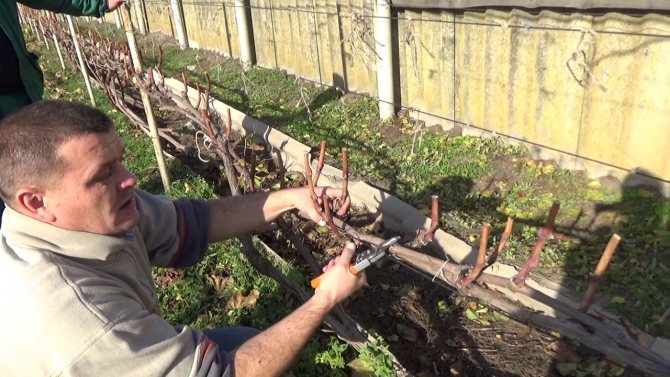

Pruning in the fall, after the first year, removes only that part of the vine that has not developed for various reasons. It is carried out closer to the root. The rest of the operations should be postponed until spring.
Note!
If during the first year of life the plant does not ripen, 3 or less shoots appear on it, then in this case they are not removed. Such a plant should not be cut off, you can simply shorten it and leave at least 8 buds.
Taking proper care of your grapes will help you grow a healthy plant that will delight you with the number of fruits and their taste. There is nothing complicated in this process, so you just need to know the rules of care.
When to prune
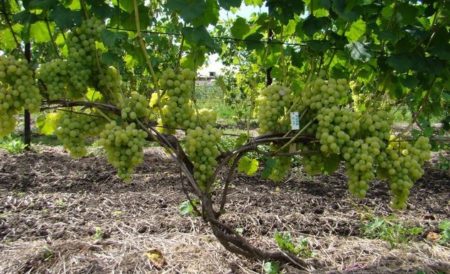

Depending on the age of the grape, its variety, climatic conditions, one or the other is made. The event can be held in spring or autumn.
The grape bush has stages of growth:
- Young grapes. Age up to five years. All this time it does not bear fruit, but fruitful branches of the vineyard are created. Pruning is needed for this.
- Ripe grapes. The vineyard bears fruit for up to 25 years. Pruning is carried out in order for new shoots to grow. Old ones are removed to create fruitful bush branches.
- Old grapes. To continue fruiting and rejuvenating the bush, they carry out mandatory pruning. This is done when the plant is dying out.
Features of pruning grapes at different ages
With the onset of autumn, along with the fallen leaves, pests fell into the ground, while others remained to winter on the vine. By trimming the bush, you can spray the vines and destroy the pests.
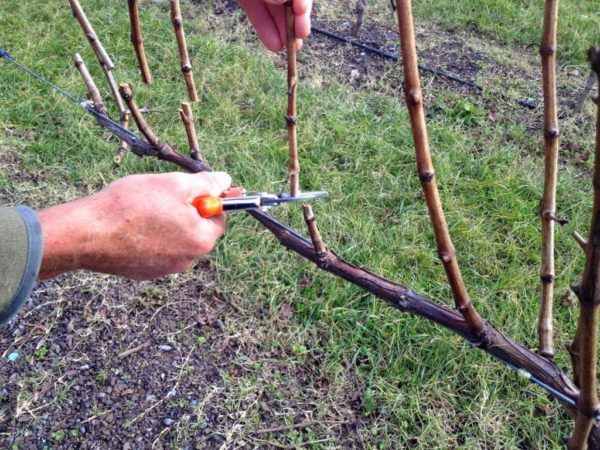

The grapes are covered for the winter so that they do not freeze out. Pruned vines are easier to tie and shelter from frost.
It may be interesting Grapes "Kishmish" and its varieties Having planted grapes "Transfiguration" - you will be satisfiedHow to care for grapes in summer to get a good harvest
In November, after the grapes have been pruned, they are better prepared for winter.
- During the growing season, not all of the vine has time to ripen, this happens when there is a lack of fertilizers or in dry summers. The plant takes a lot of energy to prepare for winter. This vine must be pruned to allow the vineyard to overwinter normally.
- The longer the vine is left for the winter, the harder it is for the grapes to survive in frost.
- A young bush of grapes also needs pruning.
In the first years of the growing season, you need to form a bush, determine the fruiting vine and the number of sleeves.
It is better to do this in the fall. And already in the third year you will form a full-fledged bush.
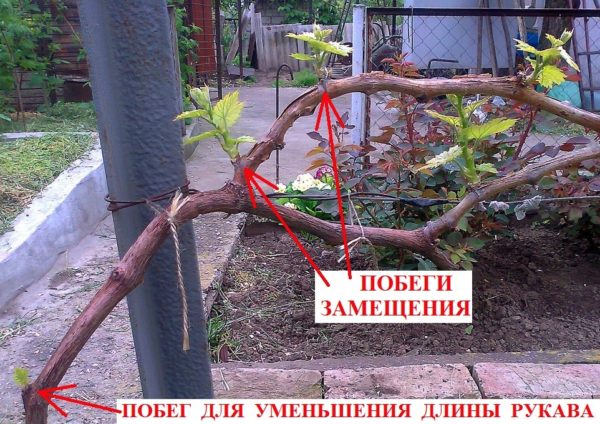

The vineyard is planted in the most conspicuous place, it is the decoration of the site, and a long vine without leaves spoils the appearance. Now pruning young grapes in the fall for beginners is to understand the purpose of this work and correctly identify unnecessary shoots and branches that need to be removed.
Features of spring and autumn pruning
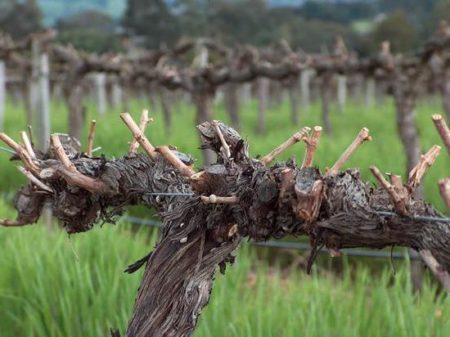

The spring pruning procedure is performed before the buds swell. Until then, until the sap flow began on the branches. It must be taken into account that the vine lets out juice, and the buds may die. This type of pruning is used in the southern regions. It is suitable for grape varieties that do not need to be insulated. Also, in the spring, a procedure for complete rejuvenation of the bush is carried out.
Autumn pruning is done after all foliage has been shed. The grape bush at this time does not receive nutrients to the extent that it needs them. Groundbait and warming for the winter are mandatory procedures. This method is used in cold regions.
Required tools and materials
In order to properly carry out autumn pruning, you will need:
- Well-sharpened pruning shears or special garden shears. It is important that the blades are very sharp, allowing you to cut the shoot in one go. Otherwise, the scissors will tear the vine and stems, which means they will injure the plant, which can lead to decay and death.
- Gloves, as many grape varieties have rather sharp growths.
- Special sticks and ropes for forming bushes. Branches tilted to the side can be fixed in front of the shelter.
- Plastic wrap, spruce branches or other covering material that can be used to cover the vine after pruning and bending to the ground.
When to prune grapes in the fall
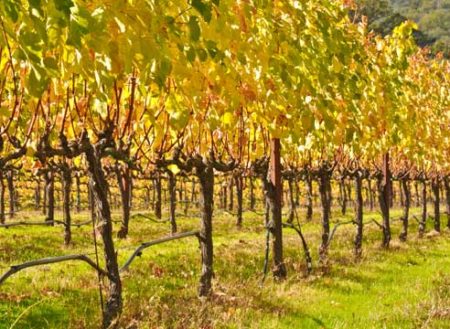

After the onset of dormancy, autumn pruning is carried out. When the bush loses all its leaves and the metabolic processes of its life will slow down. This means you can trim it without harming.
If the circumcision procedure is carried out earlier, then the plant may get sick, not get everything it needs from the foliage, or let the juice flow. Only when the first frosts come is the grape bush ready for pruning. By that time, the vine had already taken nutrients from the foliage.
Benefits of the autumn procedure
The autumn pruning procedure is aimed at increasing the future fruiting of the plant by removing excess shoots without generally weakening the growth rate of the vine, which will help maximize the future yield.
The main advantage of pruning grapes in the fall is that by the time this procedure is carried out in the vine, sap flow is reduced, and, therefore, the wounds received during the procedure will heal faster. Of course, this is not the only plus of autumn pruning. An important advantage will be the easy shelter of the grapes for the winter, because it is much more difficult to cover an uncut vine.
It is worth noting that the autumn adjustment of the grapes does not give one hundred percent guarantee of quick healing of the wounded areas of the vine. In the spring, when sap flow begins, the grapes may cry at the cut sites, which will cause the plant to lose many of the nutrients necessary for growth. As a result of profuse crying, the grapes may even die.
Let's take a look at how to prune the vine properly, when to prune it, and how to care and prepare for the winter for beginners.
Step-by-step instructions: how to prune grapes in the fall
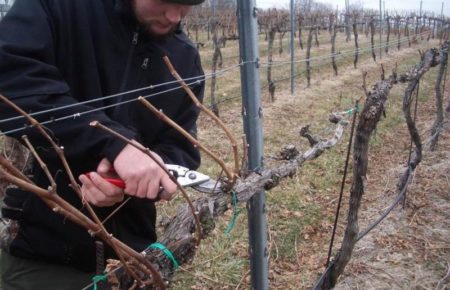

Even in hopeless cases, proper care and various manipulations will help to put the grape bush in order and achieve good yields.
- You need to start with clearing. After all the berries have been removed from the bush, you need to remove those branches on which the fruits were.
- Remove branches with less than 7 eyes.
- Shorten side shoots up to 3 sheets and cut off new shoots on perennial sleeves that have reached a size of 50 cm.
- Cut off the branches by 10% that have reached the 1st m.
- Form future fruit links on each arm: replacement vine and fruit branches. There should be 3 eyes on the replacement knot. Grow, he should, below the fruit arrow. From 5 to 15 eyes should remain, depending on the length and diameter of the branch.
- Throughout the bush, at a height of about 1 meter, from the best two vines, create a fruit link.
- For the next year, you need to choose and leave 2 shoots. Cut the upper one like a fruit arrow, the lower one, like a replacement knot. These branches will bear fruit next year. On annual young branches, only new shoots bear fruit.
- After pruning, the vine must be bent to the ground and covered. The grapes winters well under a cover of earth. The use of "non-breathable" materials is prohibited.
Trimming scheme for beginners
Currently, there are a huge number of techniques and schemes for pruning grapes. Every gardener tries to use the accumulated experience.
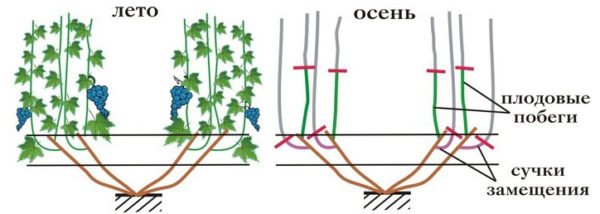

The standard scheme involves the following stages:
- The grapes should have a stump up to 5 centimeters high, from which the fruit branches will form.
- First of all, all extinct, broken off and diseased shoots are removed from the bush.
- Remove fresh green shoots.
- During autumn pruning, almost 90 percent of the mass of branches that has grown over the summer is removed.
The tips presented will help you properly prepare the bush for winter and next year.
How to prune young grapes in the fall
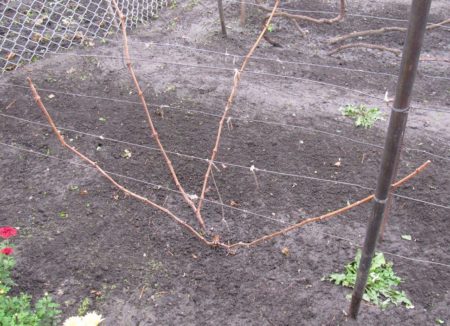

One-year and two-year-old seedlings are considered young. According to experienced gardeners, young grape bushes are best pruned in the spring. Since the bush, untouched by the pruner, tolerates winter better. Considering that the plants are still “children”, they are more likely to freeze than adult grapes. The young are pruned to create the shape of the crown. The pruning rules are the same as in the first year.
At the end of summer, the tops of the main skeleton need to be pinned. In the second half of October, remove the unripe part. In the spring, a plant that has reached two years of age is pruned, leaving 2 buds at the main branches. In autumn, for the development of grapes, young shoots are removed, and the lateral stepsons are pinched.
Grape pruning tools
A seasoned gardener needs only a pruner - this is the main tool for work.
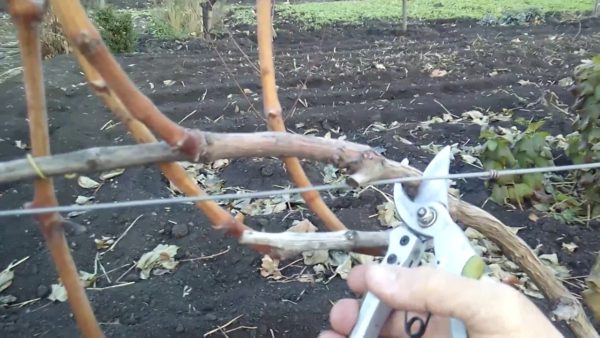

As for beginners, it is better for them to additionally arm themselves:
- Saw for pruning old and dry branches.
- With pruning shears to form a bush.
- Garden shears to remove green shoots.
- Special garden putty to treat wounds.
The entire instrument must be disinfected in a special alcohol solution. This will avoid various diseases and rotting of open wounds.
Caring for grapes before and after pruning
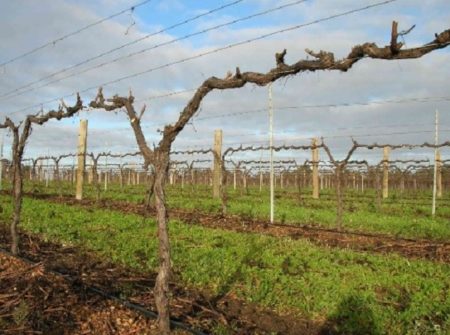

As any surgical operation requires preparation and postoperative care, so the "operation" with a grape bush requires attention.
Previously, you need to do the following:
- Examine the bush for diseased shoots. Get rid of them.
- Peel off residual foliage from branches and remove green shoots.
- Also, the plant needs to be watered, fed, cuttings prepared.
- Conduct disease prevention. You can use copper sulphate or another remedy.
- When the vine is completely dry, the bush can be insulated and covered.
Follow-up care of the vine
Even if you have successfully completed the pruning of the vine, this does not mean that the vineyard does not need attention. The main care of grapes in the fall is to treat them from bacteria and fungi. To do this, use a solution of copper sulfate (5-7%), and the mixture should be hot, about +50 degrees (Figure 6).


Figure 6. After pruning, they begin to shelter the vines for the winter
After the grape bushes are dry after processing, they begin to cover them. Additionally, you can carry out treatment with Polych or Fundazol, which will protect plants from fungi. When the plants are covered, they can be safely left on until spring.
You will find more information on pruning grapes in autumn and preparing vines for winter in the video.
Pruning by years
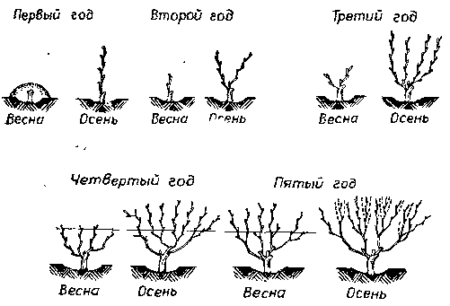

Autumn is the time for gardeners to harvest and carefully prepare the vineyard for wintering. This event involves annual pruning and other manipulations.
First year
In early April, you can remove the shelter and tie up the vine so that the tops are looking in different directions. The central pagon must be removed. Leave the two lower kidneys. In summer, 2 shoots will grow from them. In autumn, do not touch a couple of eyes from below. Cut the rest. Insulate for the winter.
Second year
In autumn, cut off the long sleeve, leaving 2 branches. Also remove the stems that grow lower in the main, leave two buds. Form a replacement knot. Form fruit arrows as follows: cut vertical stems, leaving 4 buds each. In the second year, there should already be 4 shoots. Cover the vine.
Third year
Leave vertical replacement knots. In early August, cut off the stems by 10-20 cm, the so-called chasing. If the work is done earlier, the vine will release many unnecessary and useless branches. This procedure is needed in order to increase the quantity and improve the quality of the berries.
Optimal timing
The autumn pruning procedure should be carried out after the completion of natural leaf fall, otherwise the grapes will receive less nutrients from the leaves. If leaves remain on the vine at the time of pruning, they must be removed manually.
All manipulations associated with cutting should be started immediately after the first frost, as soon as the soil begins to freeze and the air temperature is set at -1-2 ° C.
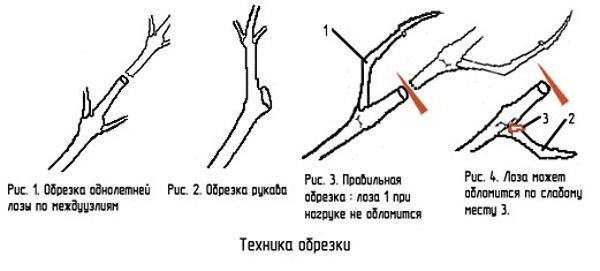

If you start pruning the vines too early, the young shoots simply won't have time to ripen. And if the procedure is carried out too late, frosts will make the shoots very brittle, which will complicate the subsequent sheltering procedure for the winter.
The table provides information on when the grapes are pruned, in what month, depending on the region.
| Region | Timing of pruning |
| Middle zone of Russia | In central Russia, a favorable temperature for autumn pruning with subsequent shelter for the winter is formed around the end of October - beginning of November. |
| Moscow suburbs | The right temperature for autumn pruning in Moscow and the Moscow region falls in mid - late November. |
| Leningrad region | The first frosts in the Leningrad region occur earlier than in the Moscow region, therefore, the favorable period of -1-2 ° C falls in the first half of October. |
| Ural | In the Urals, temperature indicators are similar to those in the Leningrad Region, therefore pruning here also begins in the first half of October. |
| Siberia | Temperature indicators -1-2 ° C in the northern regions of Russia do not linger for long. They usually fall at the end of September - beginning of October. This is the best time for pruning the vine and sheltering it for the winter. |


Important! It is worth paying attention to the fact that when choosing the timing of the autumn pruning, first of all, you need to rely on a suitable temperature and not be tied to the calendar.
Pruning for rejuvenation
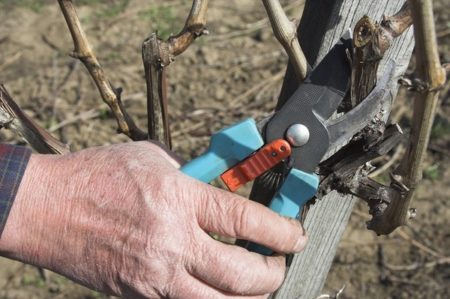

Vine rejuvenation is carried out by the method of sleeve renewal and complete rejuvenation of the grape bush. In the first case, you first need to check if the vine is alive. At the base of the sleeve, you need to cut the bark and see: if the fibers are alive, then the plant can be reanimated. It is necessary to remove dry shoots and cut off the sleeve 2-3 buds from the base. Thus, "hemp of recovery" is created.
If the grape bole is damaged by disease or pests, it must be uprooted, such a bush cannot be saved. The rejuvenation procedure should be carried out in the spring, so that new growth will grow in the summer. Leave a couple of strong vines from it, and cut them into 3 eyes in the fall. For a complete rejuvenation of the bush, you need to cut off the entire ground part, and clear the ground to a depth of 30 cm around the trunk. Make several cuts on it. Cover the cut with damp earth. The harvest in the rejuvenated vineyard will be in a couple of years.
There is also a way to renew the grapes. It is necessary to make layering from the bush. It is necessary to bury a mature vine in the ground to a depth of 40 cm, stretching the branch in length. All kidneys must be removed from it. Leave a vine with 2 buds on the surface. New pagons will appear by next summer.
How to form grapes: a scheme for pruning young bushes in the fall of 1, 2, 3 years
Let's take a closer look at how to properly shape and prune grapes every fall within 3 years after planting.
Remember! The goal of your pruning is to have 4-5 fruit-linked sleeves by age 3.
Grape pruning 1st year
You planted grape seedling in spring, and now it's time for the first formative pruning.
Pruning grapes in the fall of the 1st year is carried out as follows: you shorten your only shoot by 3-4 eyes. If you had a seedling with two shoots, then the pruning should be done symmetrically, but leaving 2-3 eyes.
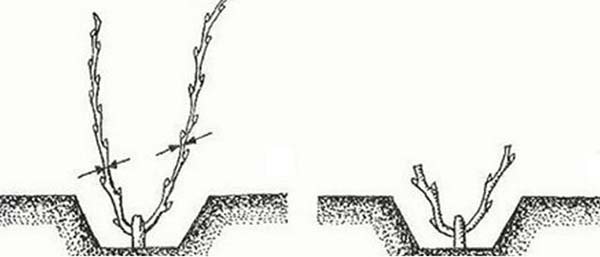

Opinion! Some particularly scrupulous growers believe that while the bushes are young, only preliminary pruning should be done in the 1st and 2nd years in the fall (that is, in the first year you need to leave 6-10 eyes), and the next year in early spring - already final (up to 3 -4 eyes). The fact is that if you immediately cut it too short, then in winter, due to its youth and insufficient frost resistance, the vine can completely freeze out.
2nd year grape pruning
If you did everything right in the fall of last year, then in the fall of this year you already have 4-5 powerful shoots (future sleeves). In this case, it is better to leave exactly 4 shoots, and the weakest or growing in an uncomfortable direction should be cut out.
Important! The bush should not look like a fan of 6-8 short shoots, 4-5 strong and long shoots should remain on it. Therefore, do not forget to carry out the summer coinage.
Pruning grapes in the fall of the 2nd year is carried out as follows: you shorten each of the shoots by 3-4 eyes, which is necessary (if it is not clear, then see paragraph "Pruning rules") so that each shoot can be normally tied to the lower wire of the trellis, that is, be located along it and not go beyond its limits.
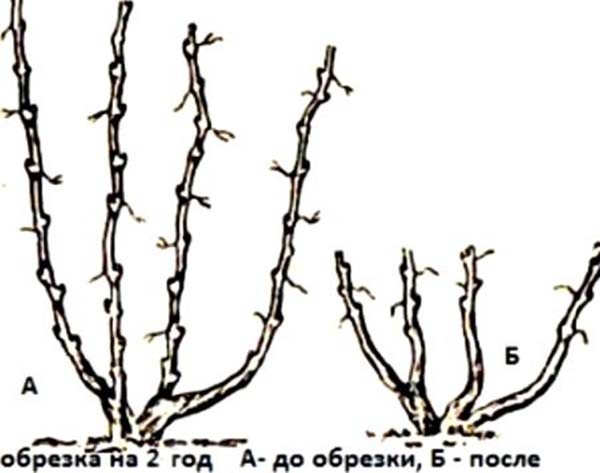

The next video shows the preliminary pruning of grapes in the second year in the fall (that is, the vine is left with a large margin, not 3-4 eyes, but 2 times more, that is, 6-8).
Advice! A stock of vines is never superfluous, because in the spring you can always complete what you started and get rid of what is not needed.
Pruning grapes from the 3rd year onwards
In the fall of the third year, the shrub will already have 4 large boles (arms), with young branches on each of them. It is on these young vines that you will begin to harvest.
By the way! Already for 3 years you will receive a small "signal" harvest.
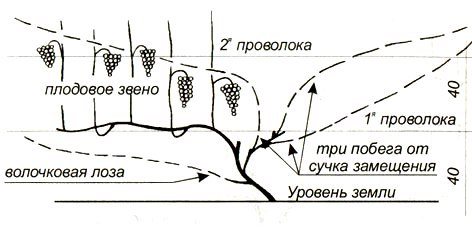

What the 1st sleeve should look like
For correct pruning of grapes in the fall of the 3rd year, the strongest shoots on each side (on each sleeve) are again selected, the weak ones are cut out and 2 strong ones are left. Of the remaining 2 powerful shoots, the lower one is shortened by 3 eyes. This will be a replacement knot. The second shoot (fruit arrow) is left with 6-10 buds.
Advice! Still, it is better to hibernate 2 strong vines (fruit arrows), and in the spring remove the one that wintered worse or is located further from the base of the bush.
Thus, in the third year, a grape bush will be fully formed, which in the future will begin to actively bear fruit.
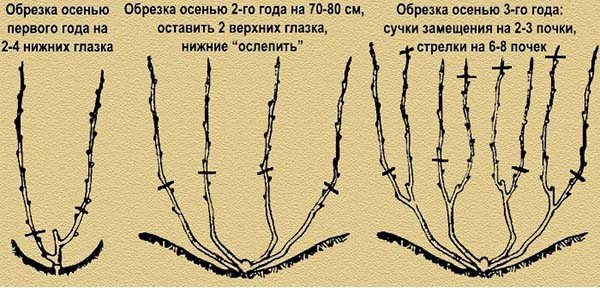

Note! The figure shows that the replacement knots need to be cut by 2-3 eyes, but it is better to leave exactly 3.
Further! In the fourth year and in all subsequent years, autumn pruning of grapes consists in removing the vine that has already fruited, and pruning the annual vine (the one that grew on the replacement heap), which will bear fruit next year (fruit arrow). The lowest vine will again be left as a replacement knot.
See the next paragraph, "Pruning a Mature Grape Bush in Autumn".
Errors
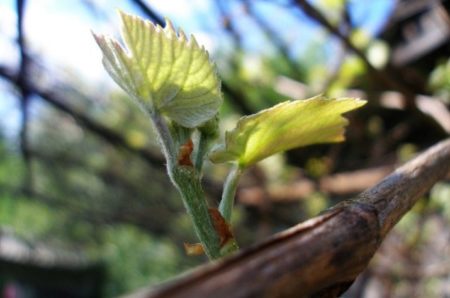

The most common mistakes lead to loss of yield, poor plant development or even death.
Minimum top cut
Long, large and beautiful branches are "a pity" to cut. Trimming is done "lightly". As a result, there is a lack of light for the vine, it becomes thin and the bush overgrows. The berry becomes shallow. Correctly you need to remove up to 70-90% of the gain.
The wrong shoots are cut
Novice growers either cut off all the young shoots and leave the old vine, or vice versa - the adult vine is removed and the young shoots are left. A double mistake is allowed. It is correct to cut out every year the shoots that have already borne fruit, as well as the thin vine thickening the bush. To get the harvest next year, it is advisable to leave a bole with several sleeves and young branches.
Hemp
The size of the hemp left is not taken into account, it is either cut off without a trace, or left too large. On adult shoots, according to the rules, no more than three cm should remain. On new vines, so that the cut does not rot, the stump does not need to be left.
Stepping
Young shoots do not break off, and they grow all summer. Or, on the contrary, they are cut completely flush with the main branch. It will be correct to leave two leaves and break off the stepsons above, removing the top.
Overview of basic pruning methods
Novice growers do not know how many eyes to leave on a particular vine bush. The answer to this question depends on the way the bush is formed, and there may be several of them.
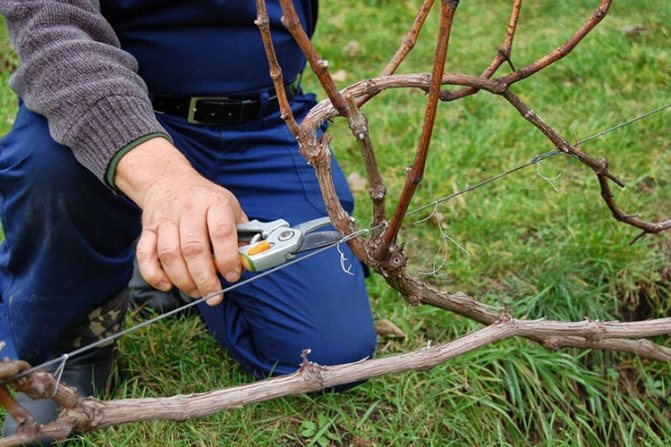

The most common are:
- Short pruning - 3-4 eyes are left on the fruit arrows. Such pruning is more often used in the fall in relation to wine grapes.
- Medium pruning - 6-8 eyes are left on the shoots. It is more often used for the formation of table grape varieties.
- Long trim - leave from eight to twelve eyes. This method is more often used for the formation of Asian grape varieties, less often for table varieties.
Another method of pruning grapes is Guyot, which combines the short and long methods listed above. With this approach, the replacement shoots are cut so that they have 3 eyes each. The fruit-bearing vine is cut off, and a new shoot grows on the replacement knot, which will bear fruit next year. This method is suitable for most grape varieties.
Try to find out the requirements for pruning specifically from your strain, they may be different. If there is no such information, use the medium pruning method or according to Guyot, so the probability of a mistake is lower.

